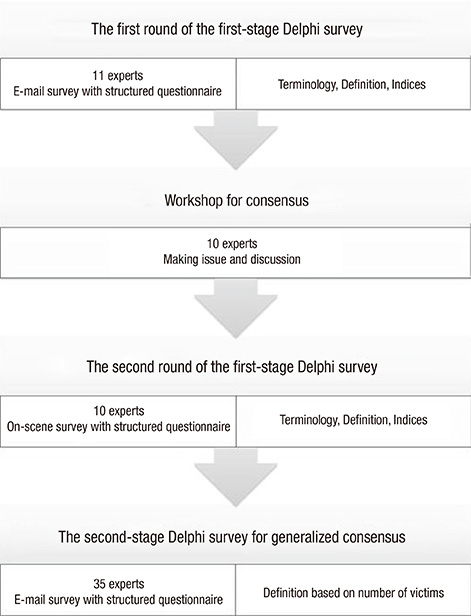J Korean Med Sci.
2014 Jan;29(1):122-128. 10.3346/jkms.2014.29.1.122.
Scientific Framework for Research on Disaster and Mass Casualty Incident in Korea: Building Consensus Using Delphi Method
- Affiliations
-
- 1Department of Emergency Medicine, Inje University College of Medicine Seoul Paik Hospital, Seoul, Korea.
- 2Department of Social and Preventive Medicine, Inha University School of Medicine, Incheon, Korea.
- 3Seoul National University Hospital Biomedical Research Institute, Seoul, Korea. juok.park@gmail.com
- 4Department of Emergency Medicine, Jeju National University School of Medicine, Jeju, Korea.
- 5Department of Emergency Medicine, Gyeongsang National University Hospital, Jinju, Korea.
- 6Department of Epidemiology, Graduate School of Public Health, Seoul National University, Seoul, Korea.
- 7Department of Emergency Medicine, Seoul National University College of Medicine, Seoul National University Boramae Medical Center, Seoul, Korea.
- KMID: 1796925
- DOI: http://doi.org/10.3346/jkms.2014.29.1.122
Abstract
- We aimed to determine the scientific framework for research on disaster and mass casualty incident (MCI) in Korea, especially Korean terminology, feasible definition, and epidemiologic indices. The two staged policy Delphi method was performed by instructors of National Disaster Life Support (NDLS(R)) with the constructed questionnaire containing items based on the literature review. The first-stage survey was conducted by 11 experts through two rounds of survey for making issue and option. The second-stage survey was conducted by 35 experts for making a generalized group based consensus. Experts were selected among instructors of National Disaster Life Support Course. Through two staged Delphi survey experts made consensus: 1) the Korean terminology "jaenan" with "disaster" and "dajung-sonsang-sago" with "MCI"; 2) the feasible definition of "disaster" as the events that have an effect on one or more municipal local government area (city-county-district) or results in > or = 10 of death or > or = 50 injured victims; 3) the feasible definition of MCI as the events that result in > or = 6 casualties including death; 4) essential 31 epidemiologic indices. Experts could determine the scientific framework in Korea for research on disaster medicine, considering the distinct characteristics of Korea and current research trends.
MeSH Terms
Figure
Cited by 4 articles
-
Disaster epidemiology in Korea
Ju Ok Park
J Korean Med Assoc. 2014;57(12):993-998. doi: 10.5124/jkma.2014.57.12.993.Disaster medicine in Korea
Soon-Joo Wang
J Korean Med Assoc. 2014;57(12):982-984. doi: 10.5124/jkma.2014.57.12.982.Emergency Medicine in Disasters
Soon-Joo Wang
Hanyang Med Rev. 2015;35(3):124-130. doi: 10.7599/hmr.2015.35.3.124.Healthcare Policy Agenda for a Sustainable Healthcare System in Korea: Building Consensus Using the Delphi Method
Seung Hoon Kim, Hye Jin Joo, Joo Youn Kim, Hyo Jeong Kim, Eun-Cheol Park
J Korean Med Sci. 2022;37(39):e284. doi: 10.3346/jkms.2022.37.e284.
Reference
-
1. Smith E, Wasiak J, Sen A, Archer F, Burkle FM Jr. Three decades of disasters: a review of disaster-specific literature from 1977-2009. Prehosp Disaster Med. 2009; 24:306–311.2. Statutes of the Republic of Korea. Framework act on the management of disaster and safety. accessed on 1 March 2013. Available at http://elaw.klri.re.kr/kor_service/lawPopupView.do?hseq=21330,21330.3. De Boer J. Definition and classification of disasters: introduction of a disaster severity scale. J Emerg Med. 1990; 8:591–595.4. Rutherford WH, de Boer J. The definition and classification of disasters. Injury. 1983; 15:10–12.5. World Health Organization. Mass casualty management system: strategies and guidelines for building health sector capacity. Geneva: WHO press;2007.6. Cryer HG, Hiatt JR, Eckstein M, Chidester C, Raby S, Ernst TG, Margulies D, Putnam B, Demetriades D, Gaspard D, et al. Improved trauma system multicasualty incident response: comparison of two train crash disasters. J Trauma. 2010; 68:783–789.7. Carley S, Mackway-Jones K, Donnan S. Major incidents in Britain over the past 28 years: the case for the centralised reporting of major incidents. J Epidemiol Community Health. 1998; 52:392–398.8. Kuisma M, Hiltunen T, Määttä T, Puolakka J, Boyd J, Nousila-Wiik M, Hakala T. Analysis of multiple casualty incidents - a prospective cohort study. Acta Anaesthesiol Scand. 2005; 49:1527–1533.9. Guha-Sapir D, Below R. The quality and accuracy of disaster data: a comparative analyses of three global data sets. Brussels: WHO Centre for Research on the Epidemiology of Disasters;2002.10. Rayens MK, Hahn EJ. Building consensus using the policy Delphi method. Policy Polit Nurs Pract. 2000; 1:308–315.11. Natioanl Emergency Management Agency. An annual report of fire administration data and statistics 2011. Seoul: Natioanl Emergency Management Agency;2012.12. Arnold JL, Halpern P, Tsai MC, Smithline H. Mass casualty terrorist bombings: a comparison of outcomes by bombing type. Ann Emerg Med. 2004; 43:263–273.13. Halpern P, Tsai MC, Arnold JL, Stok E, Ersoy G. Mass-casualty, terrorist bombings: implications for emergency department and hospital emergency response (Part II). Prehosp Disaster Med. 2003; 18:235–241.14. Dominici F, Levy JI, Louis TA. Methodological challenges and contributions in disaster epidemiology. Epidemiol Rev. 2005; 27:9–12.


